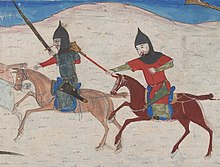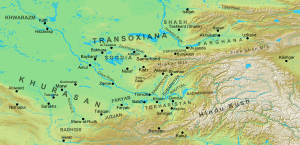35:
292:
352:. Abu 'Ali and Fa'iq fled northward; the latter sought refuge with the Karakhanids. Nuh, however, pardoned Abu 'Ali, and sent him to Khwarazm. The Khwarazm Shah, who held southern Khwarazm as a Samanid vassal, imprisoned Abu 'Ali. Both of them were captured when the Samanid governor of northern Khwarazm invaded from Gurganj. He annexed southern Khwarazm and sent Abu 'Ali back to Nuh. The amir sent him to Sebük Tigin in 996, and he was subsequently executed by the Ghaznavids.
185:
304:, in exchange for a promise from the latter to fight the Karakhanids. After some time, however, Fa'iq surrendered to Bughra Khan, who then marched toward Bukhara. Nuh fled, and the Karakhanids entered the capital in the late spring of 992, where they managed to capture Abu Ali Damghani. The amir then turned to Abu 'Ali, still residing in
245:; Nuh was forced to request Tash's assistance in crushing the revolt. The governor succeeded in this task, and prepared to fight the armies of Abu'l-Hasan and his son Abu 'Ali, along with Fa'iq. Eventually, however, he changed his mind and made peace with the Simjuris and Fa'iq. Tash convinced Nuh to give Fa'iq control of
312:
the ruler of the
Samanid dynasty as an Karakhanid puppet, traveled to Samarkand, and then died on the road northward. During the same period, Abu Ali Damghani, who was a captive of the Karakhanids, died. The garrison left in Bukhara was defeated by Nuh in the summer of that year, who had Abd al-Aziz
299:
The
Karakhanids, who in addition to their seizures of Samanid territory had inherited several petty Turkish principalities that had been virtually independent from Bukhara, launched a full-scale invasion at the end of 991. Their ruler, Bughra Khan, destroyed an army sent by Nuh to stop him. The amir
256:
This peace was broken by 'Utbi's successor
Muhammad ibn 'Uzair; the vizier had been rivals with 'Utbi and therefore disliked Tash. Nuh, due to Muhammad's advice, stripped Tash of his office and reinstated Abu'l-Hasan to the governorship. Tash fled to the Buyids, who provided him with assistance. The
355:
Fa'iq, meanwhile, had attempted to persuade Bughra Khan's successor Nasr Khan to launch a campaign against the
Samanids. The Karakhanid, however, instead made peace with Nuh. Fa'iq was pardoned and handed back the governorship of Samarkand. Although peace had finally been established, the years of
278:
Abu'l-Hasan also died around this time; his son Abu 'Ali succeeded him as governor of
Khurasan. This greatly increased his power, a move which alarmed Fa'iq. The quarrel between the two turned hostile; Abu 'Ali defeated Fa'iq in battle in around 990. During his retreat, Fa'iq attempted to seize
316:
Fa'iq attempted to take
Bukhara himself, but was defeated. He then fled to Abu 'Ali; the two settled their past differences and resolved to put an end to Samanid rule. They first began conquering the petty kingdoms who supported the Samanids; Abu 'Ali invaded
219:. The vizier considered Abu'l-Hasan to be too powerful; he managed to remove him from the post in 982. He replaced him with one of his own partisans, a Turkish general called Tash. Abu'l-Hasan fled to his appendage in Kuhistan, to the south of
34:
356:
conflict preceding it had heavily hurt the
Samanids; the Karakhanids had taken control of much of the northeast, while the Ghazvanids had entrenched themselves in Khurasan and the lands south of the
341:
and several other of his vassals. A battle in
Khurasan in August 994 resulted in a crushing victory for the amir and his allies. The rebels fled to Gurgan; Nuh rewarded Sebük Tigin and his son
230:
was mobilized in
Khurisan, also in 982; it was initially successful, but the Samanid forces were subsequently crushed. A Buyid invasion of the Samanid state was prevented only by the death of
360:. The governor of Khwarazm only nominally accepted Nuh's authority. It was in this greatly weakened condition that Nuh left the Samanid state when he died in 997. He was succeeded by his son
283:
inflicted another defeat on him. Fa'iq then headed back to Balkh. Nuh managed to convince several of his vassals to mobilize their forces against Fa'iq, but the latter retained his position.
308:, Khurasan's provincial capital. He requested his assistance, but the latter initially refused. The situation changed when Bughra Khan fell sick in Bukhara; he made Nuh's uncle
781:
348:
In 995 Abu 'Ali and Fa'iq returned with new forces and expelled Mahmud from
Nishapur. Sebük Tigin met up with his son and together they defeated the rebels near
555:
786:
291:
489:
468:
776:
211:
invaded and captured the upper Zarafshan Valley, where the Samanid silver mines were located. In 980 they struck again, seizing
727:
123:
687:
295:
Artwork of a battle in Khurasan in August 994 between the Samanids and the two Turkish rebels Fa'iq and Abu 'Ali Simjuri.
548:
460:
322:
541:
337:. The Ghaznavid agreed to provide assistance, and Nuh's forces were further strengthened by the help of
262:
361:
204:
266:
766:
735:
711:
309:
127:
235:
771:
679:
614:
485:
464:
446:
326:
280:
231:
114:
234:. 'Utbi attempted to regroup the army, but was assassinated by supporters of Abu'l-Hasan and
631:
380:
342:
216:
157:
450:
533:
184:
606:
598:
590:
565:
385:
330:
253:; Abu'l-Hasan was restored in Khurasan, while Tash kept his governorship of Khurasan.
215:. 'Utbi, however was focused on removing Abu'l-Hasan Simjuri, the Samanid governor of
760:
647:
203:
Having ascended the throne as a youth, Nuh was assisted by his mother and his vizier
655:
582:
479:
454:
269:
as his vizier. Six months later, however, Abu Nasr Ahmad was assassinated by the
318:
275:
of Nuh's palace, and Abu Ali Damghani was shortly re-appointed as Nuh's vizier.
208:
197:
193:
145:
456:
The Cambridge History of Iran, Volume 4: From the Arab Invasion to the Saljuqs
257:
Simjuris and Fa'iq defeated him near the end of 987, however, and he fled to
719:
525:
349:
301:
119:
87:
695:
515:
504:
338:
305:
189:
173:
169:
77:
59:
663:
271:
242:
212:
345:
with titles, and gave the governorship of Khurasan to Mahmud as well.
639:
334:
258:
227:
39:
Folio depicting Nuh II suppressing a rebel. From a manuscript of the
671:
290:
250:
246:
220:
183:
627:
511:
357:
165:
55:
537:
261:, where he died in 988. During the same year, Nuh appointed
481:
Persian Historiography to the End of the Twelfth Century
329:
from the region. Nuh then requested assistance from the
425:
423:
398:
396:
394:
300:
then pardoned Fa'iq and gave him the governorship of
626:
575:
141:
133:
113:
105:
97:
93:
83:
73:
65:
54:
21:
241:'Utbi's death sparked an uprising in the capital
265:as his new vizier, but later replaced him with
484:. Edinburgh University Press. pp. 1–319.
549:
24:
8:
388:, pg. 107, Lahore Sangmil Publications 2004
172:(976–997). He was the son and successor of
556:
542:
534:
498:
33:
18:
782:10th-century monarchs in the Middle East
164:, r. 13 June 976–22 July 997) was
372:
205:Abu'l-Husain 'Abd-Allah ibn Ahmad 'Utbi
749:indicates usurpers or rival claimants
207:. Sometime around his ascension, the
7:
429:
414:
402:
16:Amir of the Samanids from 976 to 997
279:Bukhara, but Nuh's Turkish general
161:
25:
14:
287:The Karakhanids and End of Reign
1:
478:Meisami, Julie Scott (1999).
180:Beginning and Middle of Reign
44:
787:10th-century Iranian people
249:and to Abu 'Ali control of
803:
461:Cambridge University Press
226:An expedition against the
747:
576:Regional rulers (819–857)
522:
509:
501:
321:, and repelled its ruler
69:13 June 976 – 22 July 997
32:
313:blinded and imprisoned.
777:Medieval child monarchs
739:(pretender, 1000–1004)
325:along with his father
296:
200:
294:
187:
463:. pp. 136–161.
712:Abd al-Aziz ibn Nuh
445:Frye, R.N. (1975).
297:
201:
41:Majma’ al-tawarikh
754:
753:
740:
732:
724:
716:
708:
700:
692:
684:
680:Ibrahim ibn Ahmad
676:
668:
660:
652:
644:
619:
615:Ibrahim ibn Ilyas
611:
603:
595:
587:
570:
532:
531:
523:Succeeded by
327:Abu Nasr Muhammad
151:
150:
794:
738:
736:Isma'il Muntasir
730:
722:
714:
706:
698:
690:
682:
674:
666:
658:
650:
642:
617:
609:
601:
593:
585:
568:
558:
551:
544:
535:
502:Preceded by
499:
495:
474:
451:Frye, Richard N.
433:
427:
418:
412:
406:
400:
389:
381:Tabaqat-i Nasiri
377:
263:Abu Ali Damghani
163:
128:Isma'il Muntasir
49:
46:
37:
28:
27:
19:
802:
801:
797:
796:
795:
793:
792:
791:
757:
756:
755:
750:
743:
728:Abd al-Malik II
622:
571:
562:
528:
519:
507:
492:
477:
471:
444:
441:
436:
428:
421:
413:
409:
401:
392:
378:
374:
370:
289:
182:
126:
124:Abd al-Malik II
122:
50:
47:
23:
17:
12:
11:
5:
800:
798:
790:
789:
784:
779:
774:
769:
759:
758:
752:
751:
748:
745:
744:
742:
741:
733:
725:
717:
709:
701:
693:
688:Abd al-Malik I
685:
677:
669:
661:
653:
645:
636:
634:
624:
623:
621:
620:
612:
607:Ilyas ibn Asad
604:
599:Ahmad ibn Asad
596:
591:Yahya ibn Asad
588:
579:
577:
573:
572:
566:Samanid Empire
564:Rulers of the
563:
561:
560:
553:
546:
538:
530:
529:
524:
521:
520:976–997
508:
503:
497:
496:
490:
475:
469:
447:"The Sāmānids"
440:
437:
435:
434:
432:, p. 158.
419:
417:, p. 157.
407:
405:, p. 156.
390:
386:Minhaj-i-Siraj
371:
369:
366:
288:
285:
267:Abu Nasr Ahmad
232:'Adud al-Daula
181:
178:
149:
148:
143:
139:
138:
135:
131:
130:
117:
111:
110:
107:
103:
102:
99:
95:
94:
91:
90:
85:
81:
80:
75:
71:
70:
67:
63:
62:
52:
51:
38:
30:
29:
15:
13:
10:
9:
6:
4:
3:
2:
799:
788:
785:
783:
780:
778:
775:
773:
770:
768:
765:
764:
762:
746:
737:
734:
729:
726:
721:
718:
713:
710:
705:
702:
697:
694:
689:
686:
681:
678:
673:
670:
665:
662:
657:
654:
649:
648:Ismail Samani
646:
641:
638:
637:
635:
633:
629:
625:
616:
613:
608:
605:
600:
597:
592:
589:
584:
581:
580:
578:
574:
567:
559:
554:
552:
547:
545:
540:
539:
536:
527:
518:
517:
513:
506:
500:
493:
491:9780748612765
487:
483:
482:
476:
472:
470:0-521-20093-8
466:
462:
459:. Cambridge:
458:
457:
452:
448:
443:
442:
438:
431:
426:
424:
420:
416:
411:
408:
404:
399:
397:
395:
391:
387:
383:
382:
376:
373:
367:
365:
363:
359:
353:
351:
346:
344:
340:
336:
332:
328:
324:
323:Shah Muhammad
320:
314:
311:
307:
303:
293:
286:
284:
282:
276:
274:
273:
268:
264:
260:
254:
252:
248:
244:
239:
237:
233:
229:
224:
222:
218:
214:
210:
206:
199:
195:
191:
186:
179:
177:
175:
171:
167:
159:
155:
147:
144:
140:
136:
132:
129:
125:
121:
118:
116:
112:
108:
104:
100:
96:
92:
89:
86:
82:
79:
76:
72:
68:
64:
61:
57:
53:
42:
36:
31:
20:
703:
656:Ahmad Samani
583:Nuh ibn Asad
510:
480:
455:
410:
379:
375:
354:
347:
315:
298:
277:
270:
255:
240:
225:
202:
153:
152:
40:
331:Sebük Tigin
319:Gharchistan
310:Abd al-Aziz
209:Karakhanids
198:Tokharistan
194:Transoxiana
146:Sunni Islam
109:22 July 997
74:Predecessor
48: 1425
767:997 deaths
761:Categories
731:(999–1004)
439:References
723:(997–999)
720:Mansur II
707:(976–997)
699:(961–976)
691:(954–961)
675:(943–954)
667:(914–943)
659:(907–914)
651:(892–907)
643:(864–892)
618:(856–867)
610:(819–856)
602:(819–864)
594:(819–855)
586:(819–841)
569:(819–999)
526:Mansur II
430:Frye 1975
415:Frye 1975
403:Frye 1975
362:Mansur II
302:Samarkand
120:Mansur II
88:Mansur II
84:Successor
772:Samanids
696:Mansur I
632:Khorasan
516:Samanids
505:Mansur I
339:Khwarazm
306:Nishapur
281:Bektuzun
217:Khurasan
190:Khurasan
174:Mansur I
170:Samanids
142:Religion
137:Mansur I
78:Mansur I
60:Samanids
43:, dated
664:Nasr II
514:of the
453:(ed.).
272:ghulams
243:Bukhara
213:Isfijab
188:Map of
168:of the
158:Persian
58:of the
704:Nuh II
640:Nasr I
488:
467:
343:Mahmud
335:Ghazna
259:Gurgan
228:Buyids
154:Nuh II
134:Father
22:Nuh II
715:(992)
683:(947)
672:Nuh I
628:Amirs
449:. In
368:Notes
251:Herat
247:Balkh
236:Fa'iq
221:Herat
115:Issue
66:Reign
512:Amir
486:ISBN
465:ISBN
358:Oxus
196:and
166:amir
106:Died
98:Born
56:Amir
630:of
384:by
350:Tus
333:of
162:نوح
101:963
26:نوح
763::
422:^
393:^
364:.
238:.
223:.
192:,
176:.
160::
45:c.
557:e
550:t
543:v
494:.
473:.
156:(
Text is available under the Creative Commons Attribution-ShareAlike License. Additional terms may apply.

